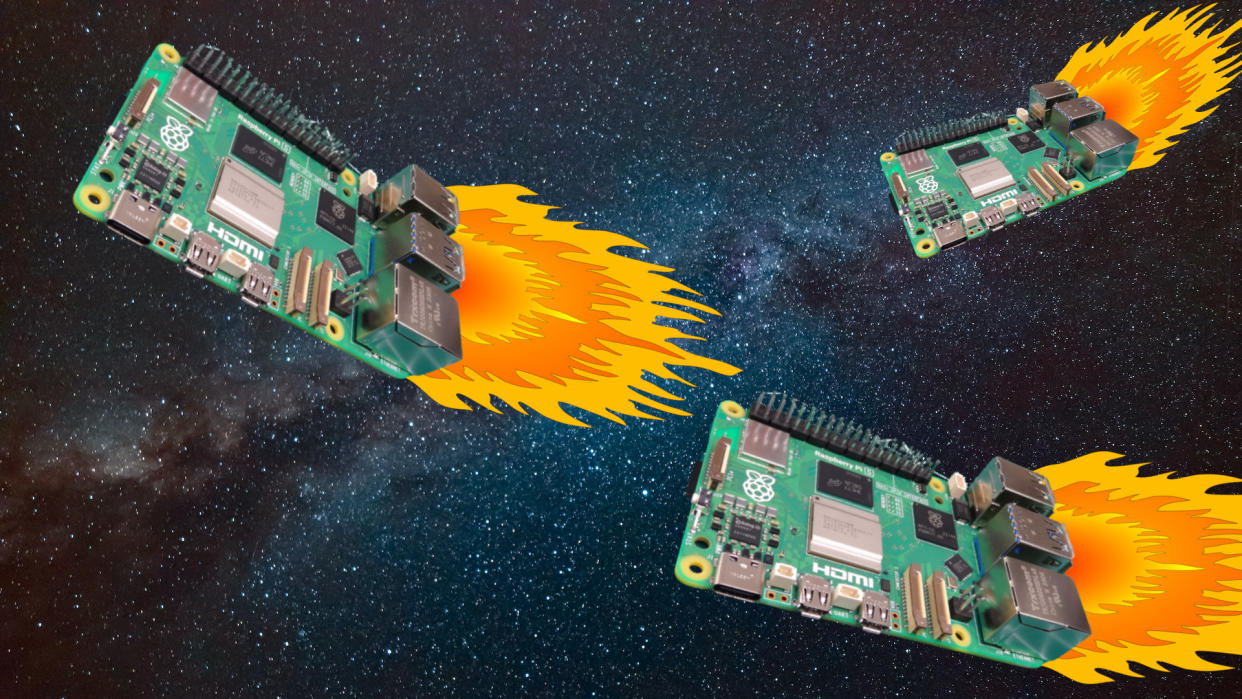We Overclocked Raspberry Pi 5 to 3 GHz, Up to 25% Perf Boost

The Raspberry Pi 5 is here and we have already reviewed it, pushing it to its limits, or so we thought. Just how far can you push a Raspberry Pi 5? We decided to take it upon ourselves to overclock both the impressive 2.4-GHz Arm Cortex-A76 64-bit CPU and the new 800 MHz VideoCore VII GPU and found we could push both to new heights of 3 GHz and 1.1 GHz.
With the overclocks, we got noticeably better performance -- up to 25% in some processor-heavy workloads. However, on graphics-intensive tasks such as video streaming or gaming, we didn't see many gains.
Overclocking CPU and GPU








In testing for our review, we had already proven that our Raspberry Pi 5 could stably overclock to 3 GHz (silicon lottery allowing) but we never overclocked the VideoCore VII GPU. So after a quick "sanity test" to 900 MHz in order to see if the GPU was overclockable we decided to go for broke and pushed the VideoCore VII to 1 GHz. No over voltages, no warranty breaking hackery, just a few lines of text in the config.txt file and we had a free speed boost.
To check that the system was stable we ran a five minute Stressberry test. All four CPU cores were pushed to 3 GHz for the full duration. No instability, no graphical corruption, just a snappier desktop experience. During the stress test, the Pi 5 used 10 watts and reached between 69 and 74 degrees Celsius. At idle, we saw a temperature around 46 degrees degrees with 3 watts of power consumption.
We used the official Raspberry Pi 5 cooler during our overclocking tests. While you can try to use one of the third-party coolers that were made for the Pi 4, they don't fit perfectly and passive cooling just won't cut it.
We should also say that, while Associate Editor Les Pounder didn't experience any instability with his Pi 5 at 3 GHz, Editor-in-Chief Avram Piltch did see his unit freeze a few times when he attempted to run benchmarks such as Geekbench 5.4. However, the stress test also ran smoothly for him.
We wanted to test YouTube performance on both Firefox and Chromium, specifically the number of dropped frames. Our desktop resolution was 2560 x 1440 but we kept video playback to 1080p, 60 fps. On each browser we played Big Buck Bunny for one minute and recorded the number of dropped frames at the mark.
It seems that overclocking doesn't really benefit YouTube video playback. In fact our best performance was at stock speeds using Firefox. We saw only 14.4% dropped frames in one minute of video. When we compare this to 1 GHz GPU (24.6%) and 1.1 GHz GPU (23.8%), the situation was actually a little worse. There appears to be no real benefit to stressing out the GPU if all we want to do is watch YouTube videos.
What about gaming? We'd already tested Dreamcast emulation via the ReDream emulator and even at stock speeds it ran beautifully. At 2560 x 1440 it played Jet Set Radio at 59/60 fps. Could we get better performance with an overclock? Long story short, no, the fps counter stayed the same. But an overclock may help other consoles hit the magic 60 fps (we're looking at you N64, PSP Sega Saturn).
Where can Overclocking be of Benefit?
When you need raw computational power, the power to crunch numbers, then a little more clock speed can be a good thing. We ran the Sysbench synthetic CPU benchmark and, at stock during a single thread test, we got 2,729 events per second and, running four threads, we saw 10,921 events per second. Compare that to the Raspberry Pi 4 which scored on 1,766 and 7,068 respectively.
After overclocking to the CPU to 3 GHz and GPU to 1.1 GHz, we saw a marked improvement. A single thread score of 3,423 and multi-core of 13,681. That is a 25% improvement for both single and four threads. Not bad and all it cost us was a little config file trickery.

Out final test was 7-Zip benchmark which tests hash calculation methods, compression and encryption codecs using 7-Zip. The stock Raspberry Pi 5 performed compression at 9,543 MIPS, over double what the Raspberry Pi 4 (4287) could achieve. For decompression, the Pi 5 managed 13,231 MIPs, just under double the Pi 4's score of 7568 MIPS.

What performance boost does overclocking afford us? In compression we saw a score of 10,356 MIPS, an 8% improvement over stock. For decompression we recorded a score of 16,238 MIPS, a healthy 20% boost.
We've yet to test AI / Machine Vision. How would TensorFlow perform on the Raspberry Pi 5? On the Pi 4 it ran, ok, but a low FPS crippled its performance. Could the Raspberry Pi 5 unlock a lower cost platform for AI / ML?
